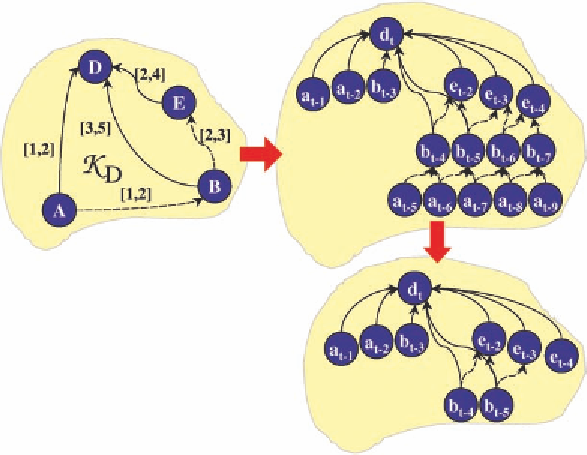Information Technology Reference
In-Depth Information
Temporal disaggregation of Causal f unction Kernels
Since an unknown causal function to be approximated does not exist between variables but rather be-
tween their lagged time series, the eCFKs have to be temporally disaggregated. Therefore this approach
uses the window of impact as identified by the causal proof procedure: While the dependent variable
Y
is represented by its instantaneous time series
y
t
as an output node, each independent variable leads
to a number of input nodes corresponding to the length of the appropriate window of impact. These
input nodes each represent one lagged independent time series within the window of impact. As far as
eCFKs are concerned, it is necessary to introduce a second input layer which accounts for auxiliary
cause-and-effect relations: The time series of the second layer are derived by the same procedure as
described above taking the influenced indirect time series of the auxiliary association as output node
and the influencing element as input node. Second input layer elements which affect first layer time
series and the output node directly are of specific interest because they combine direct and indirect
influence as it is shown in Figure 4 for the extended causal function kernel
K
D
. All other second layer
input elements where this overlap does not exist can be eliminated from the temporally disaggregated
causal function kernel (dCFK) since they are already encompassed by another (d)CFK.
As temporal disaggregation delivers the appropriate input and output nodes for a neural function
approximator in the form of temporally lagged time series there remains the issue to complete the
model selection of the ANN. This includes an adequate dimensioning of the hidden layer(s) as well as
the selection of input and transfer functions for all ANN-nodes.
Since the universal approximation property postulates a limitation of the inner function of Kolmogo-
rov's theorem, it is necessary to use transfer functions which map the input values to a certain output
interval. This class of so-called squashing functions encompasses sigmoid as well as logistic sine or
Figure 4. Temporal disaggregation of (e)CFKs

Search WWH ::

Custom Search